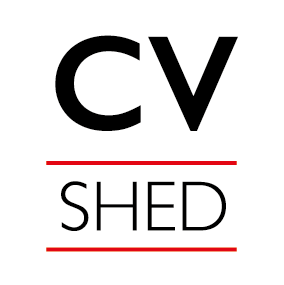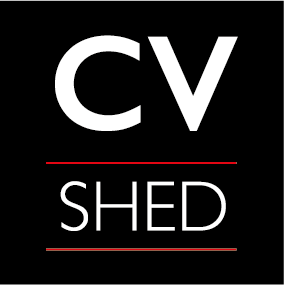Everything you need to know about writing a CV
Faced with a blank document in front of you and a lifetime of work behind you, writing a CV can seem like a daunting – maybe even impossible – task. Fear not though – your knight in shining armour is here! In this article, CV Shed shares everything you need to know about writing a CV.
Write for your audience
The number one rule, when you start putting pen to paper – or finger to keyboard – is to write for your audience. Tell them what they need to know, in an easily-digestible way. That means:
- Telling them what they need to know, without bogging them down in irrelevant detail
- Explaining to them how you can meet their needs, not how they can meet yours
- Showing why you’re the right person for the job, above any other candidate
And while content may be king, layout is (at the very least) queen. That means:
- Making it easy for the reader to pick out key information at a glance
- Choosing a smart, professional and easy-to-read Layout
- Keeping it concise and to-the-point
The audience you’re aiming to attract, with your master CV, is hiring managers within your target companies and recruiters. When you tailor your master CV to specific roles you may have a more focused audience in mind, but it’s recommended that you start with a master CV. That way, you can keep all the relevant information in one place, add to it as your career progresses and tailor it to every role you apply for with minimal bother.
Put your CV structure in place
So now you know where you’re going, it’s time to think about how to get there. Staring at a blank piece of paper, or a blank screen, is stressful – so it’s time to get some words on the page. Putting your headers in place is an easy way to start writing a CV. You can change the spacing later, but the main headers you’ll need when writing your CV are:
- Professional Profile
- Key Skills
- Career History
- Qualifications
Depending on your personal circumstances, you may also want to add:
- Professional Development
- Volunteering
- IT skills
- Languages
And don’t forget the most important header of all – your name and contact details at the very top.
Now you have some words on the page, the rest of the CV should feel less daunting. You just have to add some details into each section!
Get writing a CV!
Best practice for CVs says that they should be written without pronouns. It’s a slightly weird way of writing about yourself, which takes a bit of getting used to, but it does make the CV sound more professional and also helpfully cuts down on the word count to make it a bit snappier.
Another way to rein in the waffle is to write in bullet points, keeping each point to 2 lines or fewer. This is particularly effective in the Career History section, but can be adopted pretty much anywhere on the CV. Bullet points are also an effective way of keeping your reader’s attention, because the alternative of long paragraphs makes walls of text that can be hard – and rather off-putting – to read on a screen.
But what should you write? Think of your CV as your own personal sales document. If there’s something from your career, past or present, that would sell you into a role, it should go on the CV. Anything else can be left off. So your Saturday job in a shoe shop can safely be eliminated in favour of your recent career as a senior executive at a bank – unless you’re aiming for a career change and want to start retailing shoes again!
- Tell them what they need to know
- Don’t tell them what they don’t need to know
Things your reader doesn’t need to know include your family situation, what you were doing 30 years ago, your National Insurance number and your dog’s name (I have seen all of these and more in my years as a professional CV writer!). As a general rule, if it doesn’t affect your ability to do a job, you don’t even need to think about it when writing a CV - let alone include it.
Tidy and polish
There’s plenty of information elsewhere on my blog to direct you on the content when you’re writing a CV. After all, it’s important to know what to include and how to frame it on what is, essentially, an advert for yourself. What you will need to do however, when you’ve nailed the content, is to make sure it’s beautifully presented and error-free. In terms of presentation, the key rules are:
- Don’t use templates you’ve found on Word, Canva or your mate’s laptop – however fancy they seem – as they’re unlikely to be ATS-friendly
- Keep it smart and professional – no images, graphics or over-the-top colours
- Use a common, easy-to-read font in an easy-to-read size
There are some simple ways to make sure your CV is error free, too:
- Sleep on it, then come back for a final read-through with fresh eyes
- Use the Read Aloud function on Word, to hear what you’ve actually written – not what you think you’ve written
- Get a friend or family member to proofread it for you
- Ask Chat GPT for feedback on your spelling and grammar
Tailor the CV
Now that you have your perfect master document, the final step is writing a CV aimed at whichever particular role you fancy applying to.
Take your master CV and save it with a different file name, so that all your hard work so far isn’t lost. Then, armed with the job advert, start tailoring and tweaking. If you did a good job on your master CV, it should almost be as easy as deleting the irrelevant information in order to leave only those parts that perfectly align with the role you’re after. In reality, you’ll probably also need to make a few changes to the Professional Profile and ensure that you’ve included the main keywords from the advert.
Ta-daaaaaaah! You’re ready to apply and blow them away!
Or, get help writing a CV for your dream job
If all this sounds like too much bother, never fear. I actually enjoy this kind of stuff! Send me what you’ve got so far, we’ll have a chat on the phone and in no time at all you’ll be the proud owner of a knock-out CV. My CVs have been acknowledged for inspiring job hunters with confidence in their abilities, as well as for landing interviews. Why not see what I can do for you?




